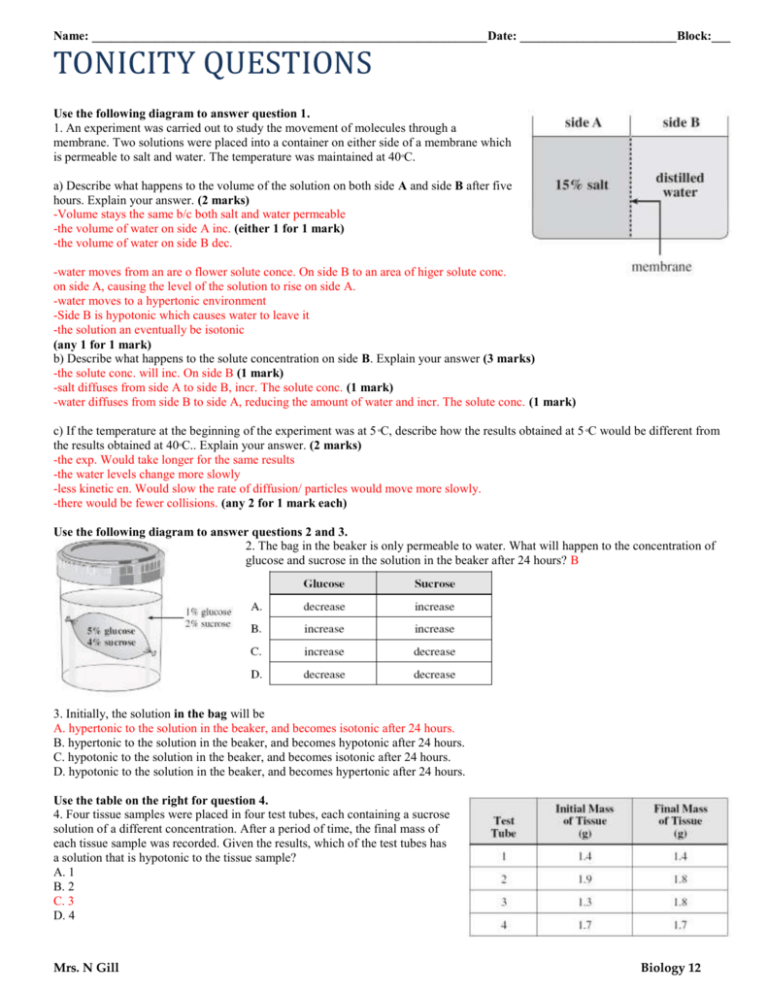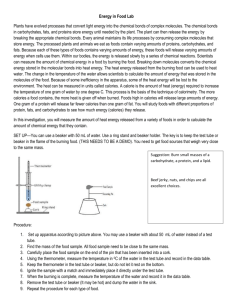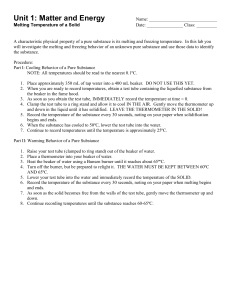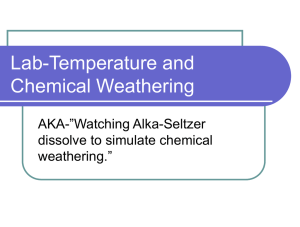Name: : :___ TONICITY QUESTIONS Use the following diagram to
advertisement

Name: _______________________________________________________________Date: _________________________Block:___ TONICITY QUESTIONS Use the following diagram to answer question 1. 1. An experiment was carried out to study the movement of molecules through a membrane. Two solutions were placed into a container on either side of a membrane which is permeable to salt and water. The temperature was maintained at 40oC. a) Describe what happens to the volume of the solution on both side A and side B after five hours. Explain your answer. (2 marks) -Volume stays the same b/c both salt and water permeable -the volume of water on side A inc. (either 1 for 1 mark) -the volume of water on side B dec. -water moves from an are o flower solute conce. On side B to an area of higer solute conc. on side A, causing the level of the solution to rise on side A. -water moves to a hypertonic environment -Side B is hypotonic which causes water to leave it -the solution an eventually be isotonic (any 1 for 1 mark) b) Describe what happens to the solute concentration on side B. Explain your answer (3 marks) -the solute conc. will inc. On side B (1 mark) -salt diffuses from side A to side B, incr. The solute conc. (1 mark) -water diffuses from side B to side A, reducing the amount of water and incr. The solute conc. (1 mark) c) If the temperature at the beginning of the experiment was at 5 oC, describe how the results obtained at 5 oC would be different from the results obtained at 40oC.. Explain your answer. (2 marks) -the exp. Would take longer for the same results -the water levels change more slowly -less kinetic en. Would slow the rate of diffusion/ particles would move more slowly. -there would be fewer collisions. (any 2 for 1 mark each) Use the following diagram to answer questions 2 and 3. 2. The bag in the beaker is only permeable to water. What will happen to the concentration of glucose and sucrose in the solution in the beaker after 24 hours? B 3. Initially, the solution in the bag will be A. hypertonic to the solution in the beaker, and becomes isotonic after 24 hours. B. hypertonic to the solution in the beaker, and becomes hypotonic after 24 hours. C. hypotonic to the solution in the beaker, and becomes isotonic after 24 hours. D. hypotonic to the solution in the beaker, and becomes hypertonic after 24 hours. Use the table on the right for question 4. 4. Four tissue samples were placed in four test tubes, each containing a sucrose solution of a different concentration. After a period of time, the final mass of each tissue sample was recorded. Given the results, which of the test tubes has a solution that is hypotonic to the tissue sample? A. 1 B. 2 C. 3 D. 4 Mrs. N Gill Biology 12 Name: _______________________________________________________________Date: _________________________Block:___ 5. What happens when a cell is placed in a hypotonic solution? A. The cell swells. B. The cell shrinks. C. The cell metabolizes faster. D. There is no effect on the cell’s volume. 6. An experiment was devised in which blood cells were placed in three beakers containing solutions of different concentrations. The results are given below. a) Describe what happened to the cells in beaker B and explain the results. (2 marks) -the cells in beaker B underwent hemolysis (swelled or burst) (1 mark) -due to water moving into the cell from an area of greater conc. of water to an area of lower conc. of water (or moving from an area of lower conc. to a greater conc.) -because the solution is hypotonic to the cells (osmosis occurs) Either 1 for 1 mark b) Describe what happened to the cells in beaker C and explain the results. (2 marks) -the cells in beaker C underwent crenation or shrunk (1 mark) -due to water leaving the cells and moving into the area of greater conc. (or water moving from an are of higher conc. to an area of lower conc. of water). -b/c the solution is hypertonic to the cells. Either 1 for 1 mark c) Explain why the solution in beaker A is isotonic to the red blood cells. (1 mark) -the solute conc. is the same as that of the red blood cells. 7. Red blood cells are placed in a highly concentrated salt solution. Which of the following describes their environment and what would happen to the cells? D Use the following micrographs to answer question 8. 8. Red blood cells were placed in an unknown solution. Micrographs were taken at the start of the experiment and after two minutes. The movement of which component of the solution caused the observed change? A. salt B. water C. protein D. glucose Mrs. N Gill Biology 12 Name: _______________________________________________________________Date: _________________________Block:___ Use the following diagram to answer question 9. 9. A thistle tube contains 10% solution of NaCl and the end is covered by a semi-permeable membrane which is permeable to salt and water. It is placed in a beaker containing a 20% salt solution. After 15 minutes the concentration and height of the solution in the tube has A. increased and the solution level will be at X. B. decreased and the solution level will be at X. C. increased and the solution level will be at Y. D. decreased and the solution level will be at Y. 10. An experiment was conducted to determine the concentration of molecules in the cytoplasm of potato cells. The following steps were taken: 1. Five different sugar solutions were added to five numbered test tubes as shown in the data table below. 2. Five potato discs (cut from the same potato) were weighed and one disc added to each test tube. 3. After 24 hours, the potato discs were removed, blotted dry and weighed again. a) Name and describe the process that allowed the potato cells to gain and lose mass when placed in the sugar solutions. (2 marks: 1 mark for name; 1 mark for description) Name of Process: Osmosis (1 mark) Change in Mass vs. Sugar +2 Concentration 0 Description of Process: OSMOSIS IS THE DIFFUSION OF WATER (1) ACROSS A SELECTIVELY PERMEABLE MEMBRANE (1) b) Explain the change in mass of the potato disc in test tube 1. (2 marks) Change in Mass (%) In tube #1, the potato disc lost 20% of its mass. This was because the potato cells lost water (1) to the surrounding hypertonic solution (1) in the test tube. c) Draw a graph that compares the concentration of sugar solution (%) to the change in mass (%) of the potato discs. Label the x-axis as the concentration of sugar solution (%). (1 mark for correct labels and title; 1 mark for correct scale and plot; 1 mark for line of best fit) -10 -20 Marks for labeling x & y axis, including title, using space effectively, drawing a “best-fit” line, interpolation. 10 20 30 Concentration of Sugar Solution (%) Mrs. N Gill Biology 12 Name: _______________________________________________________________Date: _________________________Block:___ d) Use your graph to determine the concentration of sugar solution (%) that would be isotonic to the cytoplasm of the potato cells. (1 mark) The cells will be isotonic to a solution in which they lose no mass. Interpolation from the graph shows that this will occur at a concentration of 15%. Use the following diagram to answer question 11. 11. The diagram shows a thistle tube suspended in a solution. The initial concentrations of the solutions inside and outside the thistle tube are indicated. What will happen to the concentration of the salt solution surrounding the thistle tube? A. It will decrease as salt moves into the thistle tube. B. It will increase as salt moves out of the thistle tube. C. It will increase as water moves into the thistle tube. D. It will decrease as water and glucose move out of the thistle tube. Use the following diagrams to answer questions 12 and 13. 12. In which of the above would the level of the solution in the tube rise the fastest when the tube is placed in a beaker of distilled water? A. W B. X C. Y D. Z 13. What process moves molecules from the beaker to the tube? A. osmosis B. pinocytosis C. active transport D. facilitated diffusion 14. A 0.9% solution of sodium chloride is isotonic to red blood cells. Which of the following will result when the cells are placed in a 0.3% solution of NaCl? A. Water will move into the cells causing lysis. B. Water will move out of the cells causing lysis. C. Water will move into the cells causing crenation. D. Water will move out of the cells causing crenation. Use the following diagram to answer question 15. Mrs. N Gill Biology 12 Name: _______________________________________________________________Date: _________________________Block:___ 15. In an experiment, the bottom of a thistle tube is covered with a membrane permeable only to water. The thistle tube is filled with a 10% sucrose solution and placed in a beaker containing a 5% sucrose solution. What will happen to the solution in the tube after one hour? A. The concentration of sucrose will decrease and become isotonic to the solution in the beaker. B. The concentration of sucrose will increase and become isotonic to the solution in the beaker. C. The concentration of sucrose will decrease and become hypotonic to the solution in the beaker. D. The concentration of sucrose will increase and become hypotonic to the solution in the beaker. Mrs. N Gill Biology 12








